上海版牛津英语1a教案全册
上海版沪教版牛津英语1A教案(全册共69页)_
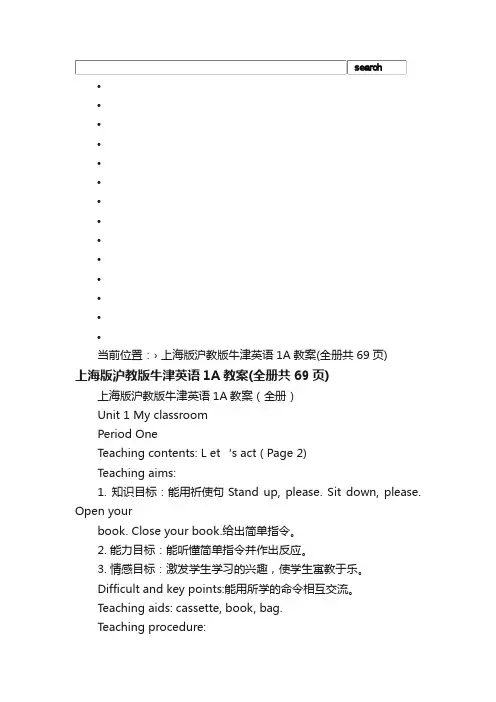
••••••••••••••当前位置:›上海版沪教版牛津英语1A教案(全册共69页)上海版沪教版牛津英语1A教案(全册共69页)上海版沪教版牛津英语1A教案(全册)Unit 1 My classroomPeriod OneTeaching contents: L et‘s act ( Page 2)Teaching aims:1. 知识目标:能用祈使句Stand up, please. Sit down, please. Open yourbook. Close your book.给出简单指令。
2. 能力目标:能听懂简单指令并作出反应。
3. 情感目标:激发学生学习的兴趣,使学生寓教于乐。
Difficult and key points:能用所学的命令相互交流。
Teaching aids: cassette, book, bag.Teaching procedure:Period TwoTeaching contents: let‘s talk ( page 3 )Teaching aims:4. 知识目标:学会问候语How are you?及回答Fine, thank you.学会Goodmorning.问候早上好。
5. 能力目标:熟练运用句子交流。
6. 情感目标:教育学生做到礼貌待人。
Difficult and key points: How are you? Good morning.的问候语。
Teaching aids: Cassette, a puppet.Teaching procedure:Unit 1 My classroomPeriod ThreeTeaching contents: let‘s learn ( page 4 )Teaching aims:7. 知识目标:学会pencil, pen, ruler, rubber, bag等学习用品。
8. 能力目标:运用各种方法简单描述物品。
(完整版)上海版牛津英语1B全册教案,推荐文档
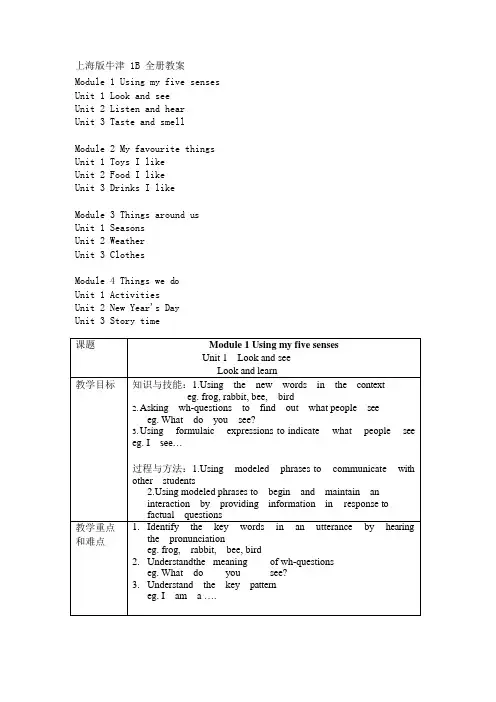
上海版牛津 1B 全册教案Module 1 Using my five senses Unit 1 Look and seeUnit 2 Listen and hearUnit 3 Taste and smellModule 2 My favourite things Unit 1 Toys I likeUnit 2 Food I likeUnit 3 Drinks I likeModule 3 Things around usUnit 1 SeasonsUnit 2 WeatherUnit 3 ClothesModule 4 Things we doUnit 1 ActivitiesUnit 2 New Year's DayUnit 3 Story timeTask in this unit:●Begin an interaction by expressing one’s preferences●Begin an interaction by eliciting a responseLanguage focus:●Using nouns to identify toys: ball,doll,bicycle,kite●Using adjectivesto describe things: It’s super.●Using the definite article to indicate particular things: the ball,the doll●Using formulaic expressions to offer people help: Can I help you?●Using formulaic expressions to offer people things: Here you are.●Using formulaic expressions to express thanks: Thank you.Language skills:Listening:●Identify the key words in an utterance by hearing the pronunciation:ball,doll,bicycle,kite●Understand the key pattern: I like…●Understand formulaic expressions to offer people things: Here you are.●Understand formulaic expressions to offer people help: Can I help you? Speaking:●Pronounce the words,phrases and sentences correctly: ball,doll,bicycle,kite ●Use formulaic expressions to indicate preferences: I like…●Use formulaic expressions to offer people things: Here you are.●Use formulaic expressions to express thanks: Thank you.●Use adjectivesto describe things: It’s super.●Use formulaic expressions to offer people help: Can I help you?Module2 / Unit 1 / Period 1Aims:1.Words: ball,doll,bicycle,kite2.Function: Use formulaic expressions to indicate preferences: I like…Language focus:1.Pronounce the words,phrases and sentences correctly2.Understand the key pattern: I like…Aids: Pictures, Realia, tape.Module 2 / Unit 1 /Period 2Aims:1. Use formulaic expressions to offer people things: Here you are.e formulaic expressions to express thanks: Thank you.e adjectivesto describe things: It’s super.e formulaic expressions to offer people help: Can I help you? Language focus:1.Understand formulaic expressions to offer people things: Here you are.2.Understand formulaic expressions to offer people help: Can I help you? Aids: Pictures, Realia, tape.Module 2 / Unit 1 /Period 3Aims:1.Review the words: ball,doll,bicycle,kite2.Review the sentences: I like …3.Drills: I like the ….Language focus:Use formulaic expressions to indicate preferences: I like the… Aids: Pictures, Realia, tape.教学效果反馈Module 2 My favourite thingsUnit 2 Food I likeTasks in this unit1.Begin an interaction by introducing one’s preferences2.End an interaction by using simple formulaic expressions3.Begin an interaction by eliciting a responseLanguage focusing nouns to identify foodeg. jelly, ice, cream, sweet, biscuiting formulaic expressions to indicate preferencese.g. I like ice cream.3.Asking yes/no questions to find out one’s preferencese.g. Do you like,…?ing formulaic expressions to confirm or denye.g. Yes./No.ing formulaic expressions to offer people thingse.g. One for you.Learning skills:Listening5.Identify the key words in an utterance by hearing the pronunciationeg. jelly, ice, cream, sweet, biscuit6.Identify specific information in response to questionse.g. Do you like sweets? No.3. Understand formulaic expressions indicating preferencese.g. I like ice cream.Speaking1.Identify the key words in an utterance by hearing the pronunciationeg. jelly, ice, cream, sweet, biscuiting formulaic expressions to indicate preferencese.g. I like …3.Asking yes/no questions to find out one’s preferencese.g. Do you like,…?ing formulaic expressions to confirm or denye.g. Yes./No.ing formulaic expressions to offer people thingse.g. One for you.The first PeriodAims:1. Words: jelly, ice, cream, sweet, biscuit6. Function: Use formulaic expressions to indicate preferences: I like…Language focus:1.Pronounce the words, phrases and sentences correctlye.g. jelly, ice, cream, sweet, biscuit2.Understand the key pattern: I like…Aids: Pictures, Radio, tape.The second PeriodAims:1.Words: jelly, ice, cream, sweet, biscuit2.Sentences: Do you like …?Yes./No.One for you and one for me.Function:1.Asking yes/no questions to find out one’s preferencese.g. Do you like,…?ing formulaic expressions to confirm or denye.g. Yes./No.Language focus:1.Asking yes/no questions to find out one’s preferencese.g. Do you like,…?ing formulaic expressions to confirm or denye.g. Yes./No.Aids: Pictures, Radio, tape.E:StepsThe third periodA:Contents :Sentence: One for you and one for you.B:Teaching Aims :Using formulaic expressions to offer people thingse.g. One for you.C:Teaching aids :Recorder and workbook ,picture cardsTasks in this unit: Module 2 My favourite things Unit 3 Drinks I like●Begin an interaction by introducing one’s preferences●End an interaction by using simple formulaic expressions●Begin an interaction by eliciting a responseLanguage focus:●Using nouns to identify drinks: cola,juice,milk,water●Using imperatives to give simple instructions: Drink some milk,Sam.●Using the indefinite determiner some to show quantity: Drink some water,Mum.●Asking wh-questions to ask for specific information about a person: What do youlike?●Using the simple present tense to express preferences: I like water.●Using formulaic expressions to wish someone a happy birthday: HappyBirthday,Eddie.Language skills:Listening:●Identify specific information in simple instructions: Drink some milk,Sam.●Identify the key words by hearing the pronunciation: cola,juice,milk,water●Identify specific information in response to simple questions: What do you like?Ilike water.●Understand formulaic expressions wishing someone a happy birthday: HappyBirthday,Eddie.Speaking:●Pronounce the words,phrases and sentences correctly: cola,juice,milk,water●Using imperatives to give simple instructions: Drink some milk,Sam.●Asking wh-questions to ask for specific information about a person: What do youlike?●Use the key pattern to express preferences: I like water.●Use adjectivesto describe things: It’s super.●Use formulaic expressions to wish someone a happy birthday: HappyBirthday,Eddie.Drinks I likeThe First PeriodAims:1.Words: cola,juice,milk,water2.Function: Use specific information in response to simple questions: What do you like? Ilike…Language focus:1.Pronounce the words,phrases and sentences correctly2.Identify specific information in response to simple questions: What do you like? Ilike…Aids: Pictures, Realia, tape.Drinks I likeThe Second PeriodAims:e imperatives to give simple instructions: Drink some milk,Sam.2.Ask wh-questions to find out one’s preferences: What do you like?e the key pattern to express preferences: I like water.Language focus:ing imperatives to give simple instructions: Drink some milk,Sam.2.Asking wh-questions to find out one’s preferences: What do you like?ing the verb like to indicate preferences: I like water.Aids: Pictures, Realia, tape.Aims:Drinks I like The Third Period1.Review the words: birthday,cola,juice,milk,water2.Review the sentences: What do you like? I like water(milk, cola,juice).e formulaic expressions to wish someone a happy birthday: Happy Birthday,Eddie. Language focus:Using formulaic expressions to wish someone a happy birthday: HappyBirthday,Eddie.Aids: Pictures, Realia, tape.教学效果反馈Module 4 Things we doUnit 2 New Year’s DayTasks in this unit:Begin an interaction and maintain it by responding to questions Using modeled phrases to communicate with other students.Use formulaic expressions to offer people thingsLanguage focus:Using nouns to identify objects e.g.,gift, card, firework, firecrackerUsing imperatives to give instructionse.g., Draw. Write. Fold.Using adjectives to describe thingse.g., newUsing formulaic expressions to greet people on New Year’s Daye.g., Happy New Year!Using formulaic expressions to offer people thingse.g., A gift for you.Using the simple present tense to express interest and preferencese.g., I like the red dress.Language skills:ListeningIdentify specific information in response to simple instructionse.g., draw, write, foldUnderstand the key patterne.g., I like the red dress.Identify the key words in an utterance by hearing the pronunciation e.g., gift, card, firework, firecrackerunderstand formulaic expressions of New Year’s greetingse.g., Happy New Year!Understand formulaic expressions offering people thingse.g., A gift for you.Understand a simple story with the help of pictures and body language SpeakingPronounce the words, phrases and sentences correctlye.g., gift, card, firework, firecrackerUse imperatives to give instructionse.g., Draw. Write. Fold.Use formulaic expression to greet peoplee.g., Happy New Year, Miss Fang.Use the pattern I like the … to express interests and preferences e.g., I like the sweets.Use formulaic expressions to offer people thingse.g., A gift for you.Use formulaic expressions to express thankse.g., Thank you.Period 1Language focus:Using nouns to identify objects e.g.,gift, card, firework, firecrackerUsing formulaic expressions to greet people on New Year’s Day e.g., Happy New Year!Using formulaic expressions to offer people thingse.g., A gift for you.Language skills:ListeningIdentify the key words in an utterance by hearing the pronunciation e.g., gift, firework, card, firecrackerUnderstand formulaic expressions of greetingse.g., Happy New Year!Understand formulaic expressions offering people thingse.g., A gift for you.Understand the meaning of the song.SpeakingPronounce the words, phrases and sentences correctly e.g., firecracker, gift, firework, cardUse formulaic expressions of greetingse.g., Happy New Year!Use formulaic expressions to offer people thingse.g., A gift for you.Use formulaic expressions to express thankse.g., Thank you.Sing the song and act it outMaterials:Student’s Book 1B, pp.42 and 45Workbook 1B, p.42, Part ACassette 1BWall picture 1BFlashcards 1B (gift, card, firework, firecracker)M4 Unit 2 New Year’s Daygift Happy New Year! card Happy New Year! firecracker A gift for you, …. firework Thank you.Exercise:Act out the dialogue with your classmates.。
沪教版牛津英语1A教学方案
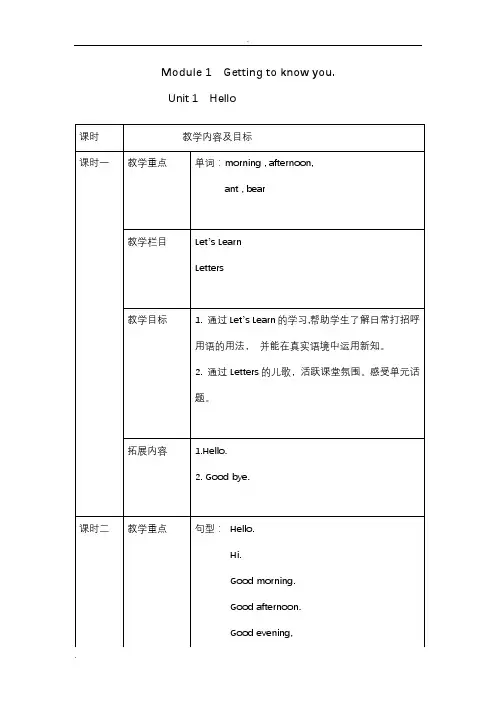
Module 1 Getting to know you. Unit 1 HelloModule 1 Unit 1 Hello【第一课时】Let’s Learn Letters (Page3 & Page5)教学任务简述(Task):1. 今天是小朋友进入小学的第一节英语课,所有的学生都表现出对英语的极大的好奇。
作为一名英语教师,要通过充满知识和乐趣的课堂将孩子们的好奇转换成对英语学习持久的兴趣和热情。
2. 班级中的孩子来自不同的环境,有着完全不同的知识基础和认知能力。
教师应主动地去了解学生,这对今后的教学工作十分重要。
目标陈述(Objectives):知识目标:能听懂会说Good morning. ? –How are you?-Fine, thank you.–Hello! 等问候语。
能力目标:学会用-Good morning. –How are you?-Fine, thank you. –Hello!来问候和交流。
情感目标:通过学生对本课问候句子的学习,培养学生讲文明的良好习惯。
并鼓励学生用这些问候语与新同学交朋友,增进新生之间的了解和友谊。
重点难点说明(Focal points and difficulties):重点:学会用单词Good morning. –How are you?-Fine, thank you. –Hello! 难点:能用所学的语句进行会话。
教辅用品说明(Aids): pictures, cards, cassette player, tape, DVD. 教学过程:Unit 1 Hello【第二课时】Let’s talk Let’s sing ( Page2 & Page4)教学任务简述(Task):有了第一堂课的基础,我和学生之间的距离拉近了,通过了解,我掌握了一部分学生的英语情况。
目标陈述(Objectives):知识目标:能听懂会说–How are you?-Fine, thank you. –Hello! 问候语。
上海版牛津英语1B全册教案
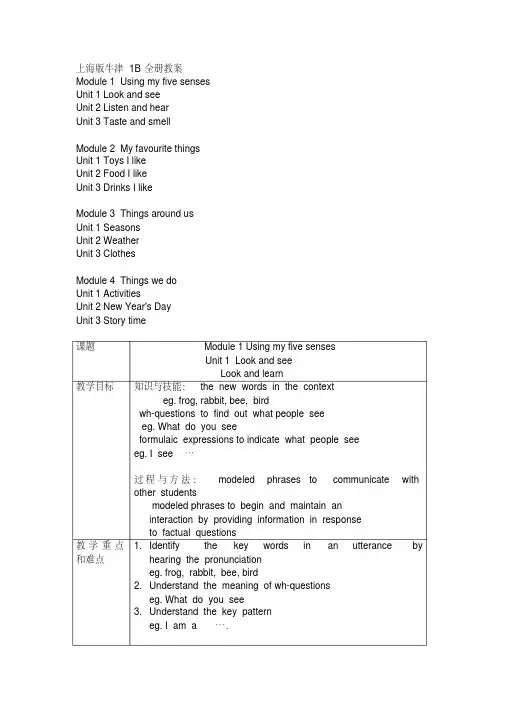
课 前 学 生 Listening to the recording of the text. 准备
教学流程
I.
Pre-task preparation:
Warming up:
Have the Ss listen to the song about the farm animals.
the new words nose, sheep, …
1. Using the sentences: What do you see What colour is it 2. Using formulaic expression to introduce the animals
what
教学媒体 Recorder and workbook ,picture cards
Module 3 Things around us Unit 1 Seasons Unit 2 Weather Unit 3 Clothes
Module 4 Things we do Unit 1 Activities Unit 2 New Year's Day Unit 3 Story time
课题 教学目标
the students to listen to the dialogue.
the key pattern What do you see I see
…
T: What do you see ?
S;I see …
the students look at the pictures and practice in pairs.
a puppet.
4. Have the Ss to act all kinds of animals.
上海牛津1A Unit1 Period1教案
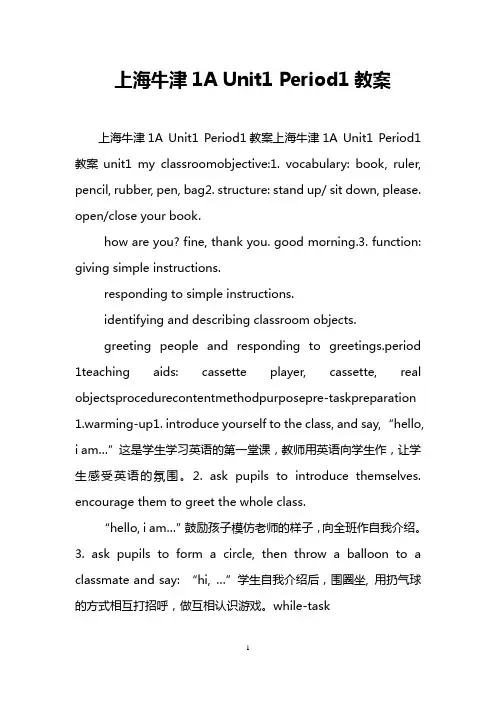
上海牛津1A Unit1 Period1教案上海牛津1A Unit1 Period1教案上海牛津1A Unit1 Period1教案unit1 my classroomobjective:1. vocabulary: book, ruler, pencil, rubber, pen, bag2. structure: stand up/ sit down, please. open/close your book.how are you? fine, thank you. good morning.3. function: giving simple instructions.responding to simple instructions.identifying and describing classroom objects.greeting people and responding to greetings.period 1teaching aids: cassette player, cassette, real objectsprocedurecontentmethodpurposepre-taskpreparation1.warming-up1. introduce yourself to the class, and say, “hello,i am…”这是学生学习英语的第一堂课,教师用英语向学生作,让学生感受英语的氛围。
2. ask pupils to introduce themselves. encourage them to greet the whole class.“hello, i am…”鼓励孩子模仿老师的样子,向全班作自我介绍。
3. ask pupils to form a circle, then throw a balloon to a classmate and say: “hi, …”学生自我介绍后,围圈坐, 用扔气球的方式相互打招呼,做互相认识游戏。
上海版牛津英语1B全册教案
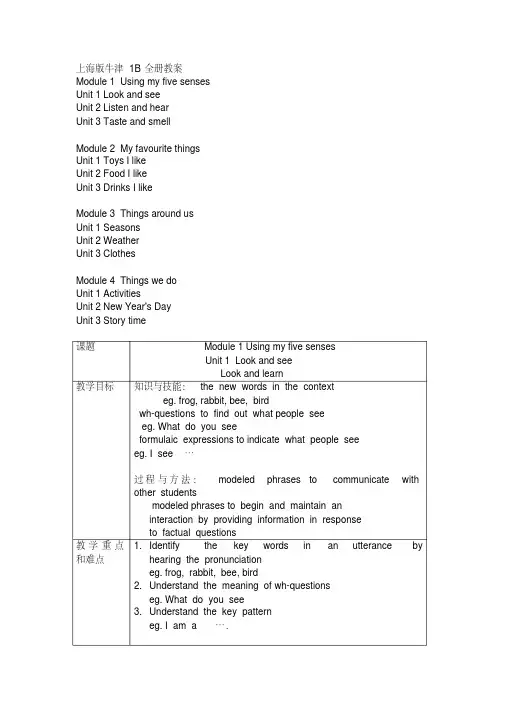
on their masks and make a dialogue with their partner.
Hello. I am a bee. I am small.
Hi , I am a frog. I am green.
While-task procedure
the students the wall pictures .
板书设计
frog rabbit bee bird I am a …
教学效果 的反馈
课题 教学目标
教学重点 和难点
Module 1 Using my five senses Unit 1 Look and see
Look and say Language Focus: Using formulaic expressions to learn the phrases; Language Skill: Listening: Understand the meanings of wh-questions Speaking: Ask wh-questions to find out what people see Use formulaic expressions to indicate what people see. Understand the meaning of wh-questions
imperatives give simple instructions eg: I hear
…
教 学 重 点 1. STRUCTURES: sheep hen dog cat
…
和难点
2. FUNCTION: Using nouns to express animals
’ noises.
一年级英文上海牛津1A教案精品
Module 1 Getting to know youUnit 1 GreetingsTasks in this unit:Begin an interaction by greeting someone politelyBegin an interaction by introducing oneself brieflyEnd an interaction with simple expressions of farewellLanguage focus:Using the key words in contexte.g., morning, afternoonUsing formulaic expressions to greet people and bid farewelle.g., Hello/Good morning./Good afternoon./Goodbye.Using a common pattern to introduce oneselfe.g., I’m…Language skills:ListeningIdentify the key words in an utterance by hearing the pronunciatione.g., morning, afternoonUnderstand formulaic expressions of greetings and farewell in context, and respond appropriatelye.g., Hello/Good morning./Good afternoon./Goodbye.Understand a common pattern for self- introductione.g., I’m…Recognize different names and be able to match the names to corresponding characterse.g., Kitty, Alice, Tom, Ben, Eddie, Danny, and Miss FangUnderstand a simple story with the help of pictures, puppets or the teacher’s body languageSpeakingUse formulaic expressions to greet people and bid farewell in the appropriate contexte.g., Good morning./goodbye.Use a common pattern to introduce oneselfe.g., I’m…Scheme of work:PeriodCore contentsExtension Materials GrammarandexpressionsVocabulary1Hello! Hi!Good morning.Goodafternoon.Goodbye.morningafternoonSB:p.2,3 and5WB:p.2and3,Parts A andC2 Hello! Hi!I’m…Nice tomeet/see you.English namesSB:p.4 and 5WB:p.2 and 4,Parts B,D,Eand TaskPeriod 1Language focus:Using the key words in contexte.g., morning, afternoonUsing formulaic expressions to greet people and bid farewelle.g., Hello./Good morning./Good afternoon./Goodbye.Language skills:ListeningIdentify the key words in an utterance by hearing the pronunciatione.g., morning, afternoonUnderstand formulaic expressions of greetings and farewell in context, and respond appropriatelye.g., Hello./Good morning./Good afternoon./Goodbye.Understand a simple story with the help of pictures, puppets or the teacher’s body languageSpeakingUse formulaic expressions to greet people and bid farewell in the appropriatecontexte.g., Good morning./Goodbye.Materials:Student’s Book 1A, p.2,3 and 5Workbook 1A, p.2 and 3 Parts A and CCassette 1ACassette playerFlashcards 1A (morning, afternoon)Character puppetsPre-task preparationsAids: Cassette 1A, Cassette playerSteps Contents Methods Purpose1Song: Goodmorning.Listen and singthe song.巩固准备期学过的歌曲。
一年级英语:上海牛津1A教案 Unit 1 My Classroom
小学英语新课程标准教材英语教案( 2019 — 2020学年度第二学期 )学校:年级:任课教师:英语教案 / 小学英语 / 小学一年级英语教案编订:XX文讯教育机构上海牛津1A教案 Unit 1 My Classroom教材简介:本教材主要用途为通过学习英语的内容,提高学生的语言技能,增加一项语言能力,有利于国际化的日常交流、生活、工作等,本教学设计资料适用于小学一年级英语科目, 学习后学生能得到全面的发展和提高。
本内容是按照教材的内容进行的编写,可以放心修改调整或直接进行教学使用。
unit 1 my classroom1、 teaching aims: ss can use imperatives to give simple instructions, such as : sit down, please.2、 teaching aids: tape recorder3、 teaching methods: visual method4、 language focus: use modeled phrases to communicate5、teaching period: 6[1]teacher’s activityss’ activityremarkspre-task1. ask ss to introduce themselves to the class, saying “hello, i am…”2. play the cassette tape for the four pictures and do the actions. ask the class to look and listen.3.play the cassette tape again and ask the class to follow your actionswhile-task1. play the tape for “stand up, please.” ask some ss to act it and the rest of the class to judge right or wrong.2. repeat the above process with “sit down, please”“open your book”“close your book”3. open the ss’ book to page 2 and read the commands for the class to follow, or play the cassette tape. ask the ss’ to point to the relevant pictures with their fingers.4. give commands and ask individual ss to repeat and actthem.post-task1. give commands “boys, stand up, please”“girls, stand up, please”“the whole class, stand up, please”2. repeat the commands and ask ss to act them.3. divide the ss into pairs. one student give commands and the other student act them. then let them change roles.4. divide the whole class into two teams, ask individual ss to give commands and to see which team is better. vary the game by letting ss to give commands to their own team or the opposite. students introduce themselves to the class, “hello, i am…”ss listen and lookss follow the tapeindividual ss carry out the commands the whole class judge right or wrongss follow the tape and point to the relevant picture.individual ss repeat and actss carry out the commandsss repeatss do pair work ss change their rolesss compete between the two teams.以打招呼的方式,引入新课,可以激发学生兴趣,消除学生的紧张。
上海版新版牛津英语A教案
上海版新版牛津英语A教案一、第一单元:单元主题与目标1.1 单元主题:本单元以“日常生活”为主题,通过学习日常生活中的常用词汇和句型,培养学生的基本交际能力。
1.2 单元目标:(1)学会使用日常英语进行简单的问候、介绍和告别。
(2)掌握日常生活中常用的单词和短语,如:hello, good morning, good afternoon, good evening, how are you, my name is, nice to meet you, e e 等。
(3)能够运用所学知识进行简单的日常交流。
二、第二单元:教学内容与方法2.1 教学内容:本单元主要学习一般现在时。
通过学习一般现在时的构成和用法,使学生能够运用一般现在时描述自己的日常活动和习惯。
2.2 教学方法:(1)采用任务型教学法,让学生在完成实际任务的过程中学习英语。
(2)运用情境教学法,创设真实的语境,让学生在实际语境中学习英语。
(3)利用游戏教学法,激发学生的学习兴趣,提高学生的参与度。
三、第三单元:教学重点与难点3.1 教学重点:(1)一般现在时的构成和用法。
(2)日常生活中的常用词汇和句型。
3.2 教学难点:(1)一般现在时的运用,尤其是情态动词的运用。
(2)词汇的拓展和运用。
四、第四单元:教学措施与评价4.1 教学措施:(1)设计丰富的课堂活动,激发学生的学习兴趣。
(2)注重个体差异,因材施教,使每个学生都能得到有效的学习。
(3)定期进行复习,巩固所学知识。
4.2 教学评价:(1)通过单元测试,检查学生的学习效果。
(2)观察学生在日常交流中的英语运用情况,评估学生的实际交际能力。
五、第五单元:教学计划与作业5.1 教学计划:(1)课时安排:本单元共需10课时。
(2)教学步骤:依次进行词汇教学、句型教学、听力教学、口语教学、书写教学和复习教学。
5.2 作业布置:(1)课后单词抄写和默写。
(2)完成课后练习题。
(3)根据自己的日常生活,用英语写一篇小作文。
沪教版牛津英语A教案完整版
Module1GettingtoknowyouUnit1GoodmorningThefirst period一、Teachingaim认知内容:能听懂会说Goodmorning.Goodafternoon. Goodevening.Goodnight.及回答。
能力要求:学会用所学句型进行情境表演。
情感态度:学会在不同时间里和人打招呼。
二、TeachingproceduresPre-taskpreparation Warmera.Sayhellotoeverybodyb.P.4songc.ElicitAlice:SheisAlice. While-taskprocedure1.RevisionmorningafternoonGoodmorning.Goodafternoon.a.Listentoadialogue(It’s8o’clockinthemorning. Aliceisgoingtoschool.Shemeet sherfriendKitty.) Goodmorning,Alice. Goodmorning,Kitty. (It’s14o’clockintheafterno on.AliceishavinganEnglishcla ss.)Goodafternoon,Alice. Goodafternoon,Miss…b.trytosaythedialoguec.playagame: accordingtothepictures,Judge thewords2.IntroductioneveningnightGoodevening.Goodnight.a.Listentoadialogueandtrytou nderstandthemeaningofthedial ogue(It’s18o’clockintheevening .Aliceishavingadinner.) Goodevening,Alice. Goodevening,dad.(It’s21o’clockatnight.Alic eisgoingtobed.)Goodnight,Alice. Goodnight,Mum.b.SayachantingroupsEvening,evening,Goodevening.Night,night,Goodnight.Post-taskactivitya.Listentothewholedialoguesb.roleplayactoutthewholedialogueing roups三、Assignmenta.Listentothetapesb.readP2,4AskandanswerWhoisshe?Thesecon dperiod一、Teachingaim认知内容:能听懂会说Howareyou?并能回答I’mfine./I’mverywell.Thank you.学会认读并且学会正确书写英语字母大小写Aa,Bb.能力要求:学会礼貌地问候别人并且礼貌回应别人的问候。
- 1、下载文档前请自行甄别文档内容的完整性,平台不提供额外的编辑、内容补充、找答案等附加服务。
- 2、"仅部分预览"的文档,不可在线预览部分如存在完整性等问题,可反馈申请退款(可完整预览的文档不适用该条件!)。
- 3、如文档侵犯您的权益,请联系客服反馈,我们会尽快为您处理(人工客服工作时间:9:00-18:30)。
Oxford English Book 1A Unit 1
the first period
一.教学说明
1.今天是小朋友进入小学的第一节英语课,所有的学生都表现出对英语的极大的好奇。
作为一名英语教师,要通过充满知识和乐趣的课堂将
孩子们的好奇转换成对英语学习持久的兴趣和热情。
2.班级中的孩子来自不同的环境,有着完全不同的知识基础和认知能力。
教师应主动地去了解学生,这对今后的教学工作十分重要。
二.教学内容
1.认知内容:能听懂会说Good morning. –How do you do? –How are you?-Fine, thank you. –Hello! 等问候语。
2.能力要求:学会用-Good morning. –How do you do? –How are you?-Fine, thank you. –Hello! 来问候和交流。
3.情感态度:通过学生对本课问候句子的学习,培养学生讲文明的良好习惯。
并鼓励学生用这些问候语与新同学交朋友,增进新生之间的了
解和友谊。
四、教学提示
1.媒体准备:
玩偶、响板、歌曲磁带
2.教学关注点:
本课中的句子例如:How are you ? Fine, thank you. 对于一些从来没有接触过英语的小朋友来说比较困难,为了解决这一问题,可从以下方面做努力。
1)注重学习的过程,为学生的学习铺好台阶;
2)在小朋友们喜欢的游戏、歌曲等活动中巩固句子;
3)多创设学生间的合作交流的机会,以缓解因差异造成的成效不一。
3.资源分享:
九年义务教学课本3A有配套的歌曲:如<Hello, how are you?>
4. 设计思路:
1)这个单元中的歌曲对于一年级的小朋友而言学起来比较困难。
而少量
多次是分解难题的有效方法,因此可将这首歌的学习安排在本单元中的
各课时中,让小朋友在几节课中,从感知到熟悉和学唱一步步的学习,
这样学起来既轻松又有成效。
3)由于Let’s talk的内容适合刚入学的一年级新生,所以将这部分内容提前到第一课时来上。
5.教学反思:
1)句型最好板书出示,加以认读。
加强音和形的联系。
2) 对于一些英语课堂用语可以进行提前感知,为下节课的学习做伏笔。
the second period
一.教学说明
1.通过第一课时的学习,学生能用Good morning. How do you do?
How are you? 来问候和交流。
2.过了解发现班中有6名同学在入学前曾系统地学过2到3年的英语,16名学生学过一些简单的英语单词和句子。
8名同学从未接触过英
语。
因此,学生在起始年级就已经出现了知识的分化。
二.教学内容
1.认知内容:
1) 学会用book, bag, pencil-box 等单词来表述单词。
2) 能听懂指令:Stand up, please. Sit down, please. 并能做出
反应。
3)学会祈使句:Open your ____. Close your ____. 并能用所学的
单词结合本句型给出指令。
2. 能力要求:
学会用祈使句来表述自己的意愿。
3.情感态度:
能礼貌地使用祈使句
四.教学提示
1.媒体准备:
单词卡片,图片,书,包,铅笔盒,录音机
2.教学关注点:
a)本课成对出现的动词反义词:open/close stand up/sit down 学生学习时容易混淆动词的含义。
建议学生在练习这些动词和句子时配上动作加以记忆和区分。
b)注意纠正学生说句子时的语音语调,防止拖音现象的发生。
c)注意让学生在一定的情景中学习,使用祈使句。
d)注意整体认读单词:pen, pencil, pencil-box
3. 设计思路:
a)对本课中教授的两组祈使句,没有面面俱到,而是做了详略处理。
对于Stand up please. Sit down, please这样的日常课堂用语,只要多用就会了,所以不必花大量的时间在机械训练上。
所以本课时只做感知和理解的要求。
b)在引出两组祈使句时,教师有意识地输入大量的句子。
既有助于学生对新句子的理解,又扩大了课堂英语输入量。
4.教学反思:
本课对学生能力拓展的训练不够。
如有条件的话,可设计一些生活化的情景让小朋友灵活运用所学句型。
Book 1A Unit 1
第三教时
一、教学说明:
1.师生和生生之间的了解更多了,在开展教学活动中,学生参与活动的积极性会明显提
高。
2.本课是继续学习有关学生身边的学习用品,如bag, book;学生也可以用一些简单句式,
如Open the …或Close the …来表述自己的意愿。
3.学生可以更熟练地表述Hello, Good morning,how are you? 等句式。
二、教学内容
1)认知内容:
a.单词ruler, pencil, pen, rubber达到“三会”要求。
b.能流利地表演儿歌。
c.能用I can see…表述看到的学习用品。
2)能力要求:
能用其他学习用品替换操练儿歌。
在学习和生活中能用所学祈使句表述自己的意愿,同时对这些命令做出反应。
3)情感态度:
在吟诵儿歌的过程中体验学习英语的快乐,同时学会爱护自己的学习用品和与别人分享学习用品。
四、教学提示:
1.媒体准备:
单词卡片,图片,录音机,学习用品等
2.教学关注点:
1)关注整体认读卡片单词ruler, rubber, pen和pencil,注意相近字型的区别。
2)虽说很多同学能说出这些学习用品,但还要关注单词的正确发音。
3)关注儿歌的语音语调,让学生学会声情并茂地朗读儿歌。
3.资料分享:
有一首英语歌曲<Can you tell me what this is?>,在学习和巩固单词时可以使用,不一定让学生唱歌曲的全部,只要在歌曲的情景中说出学习用品即可。
4.设计思路:
1)歌曲引入单词和在歌曲中巩固单词,儿歌的学习也是同样的道理。
2)充分挖掘学生已有的能力,包括英语知识和智力潜能,在完成一个个任务型活动中提高学生综合能力。
5.教学反思:
最好的教具和学具是学生周围的实物,在教学单词时要充分利用。
Unit2 Numbers
the first period
四.教学说明
1.通过第一课的学习,孩子们对英语有了初步的了解,对英语学习有了较浓厚的兴趣。
(游戏激发了他们的兴趣)
2.了解后知到,班级中有一半同学会用“Hello”跟别人打招呼,其中。
